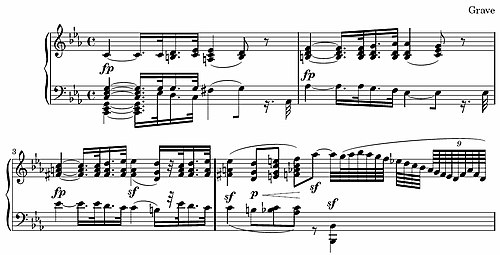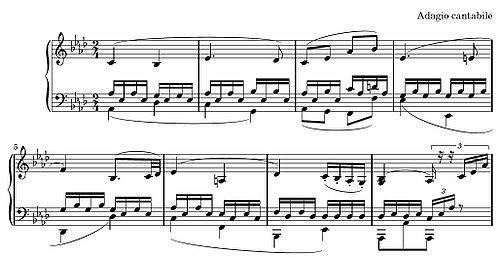you see, i could listen to this forever.
Piano Sonata No. 8 (Beethoven)
Wikipedia
Ludwig van Beethoven's Piano Sonata No. 8 in C minor, Op. 13, commonly known as Sonata Pathétique, was written in 1798 when the composer was 27 years old, and was published in 1799. Beethoven dedicated the work to his friend Prince Karl von Lichnowsky.[1] Although commonly thought to be one of the few works to be named by the composer himself, it was actually named Grande sonate pathétique (to Beethoven's liking) by the publisher, who was impressed by the sonata's tragic sonorities.[2]
Prominent musicologists debate whether or not the Pathétique may have been inspired by Mozart's piano sonata K. 457, since both compositions are in C minor and have three very similar movements. The second movement, "Adagio cantabile", especially, makes use of a theme remarkably similar to that of the spacious second movement of Mozart's sonata.[3] However, Beethoven's sonata uses a unique motif line throughout, a major difference from Haydn or Mozart’s creation.[1]
In its entirety, encompassing all three movements, the work takes approximately 19 minutes to perform
The sonata has three movements:
- Grave (Slowly, with solemnity) – Allegro di molto e con brio (Quickly, with much vigour)
- Adagio cantabile (Slowly, in a singing style)
- Rondo: Allegro (Quickly)
Grave – Allegro di molto e con brio
The first movement is in sonata form. It begins with a slow introductory theme, marked Grave. The allegro section is in 2/2 time (alla breve) in the home key of C minor, modulating, like most minor-key sonatas of this period, to the mediant, E-flat. However, Beethoven makes use of unorthodox mode-mixture, as he presents the second subject in E-flat minor rather than its customary parallel major. Beethoven extends Haydn's compositional practice by returning to the introductory section twice—at the beginning of the development section as well as in the coda. Some performers of the sonata include the introduction in the exposition repeat, others return to the beginning of the allegro section.
MIDI rendition, 6:57 minutes, 30 KB |
Adagio cantabile
The Adagio movement opens with a famous cantabile melody. This theme is played three times, always in A-flat major, separated by two modulating episodes. The first episode is set in F minor (relative to A-flat major), further modulating to E-flat major before returning to the main theme. The second episode begins in A-flat minor and modulates to E major. With the final return of the main theme, the accompaniment becomes richer and takes on the triplet rhythm of the second episode. There is a brief coda.
MIDI rendition, 5:03 minutes, 12 KB |
Rondo: Allegro
The sonata closes with a 2/2 movement in C minor. The main theme closely resembles the second theme of the Allegro of the first movement: its melodic pattern is identical for its first four notes, and its rhythmic pattern for the first eight. There is also a modified representation of the melody from the second movement, thus connecting all three movements together. The movement's sonata rondo form includes a coda. The three rondo episodes are in E-flat major, A-flat major, and C major. The movement can be thought as related to Beethoven Concerto No. 3 in C minor Op.37. The common use of sforzando creates a forceful effect.
MIDI rendition, 4:25 minutes, 17 KB |









